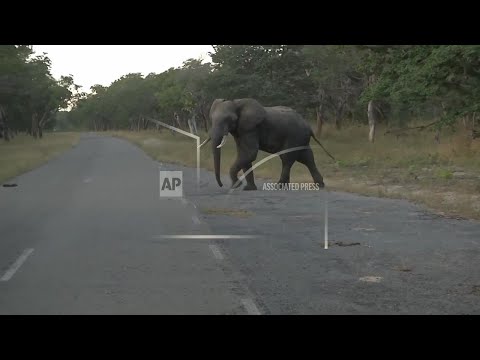(16 May 2025)
ASSOCIATED PRESS
Hwange National Park – 29 April 2025
1. Wide of elephants walking through Hwange National Park
2. Wide of park rangers walking through Hwange National Park
3. Various of vet preparing syringe to dart elephant
4. Various of Arnold Tshipa, IFAW field operations manager, using the EarthRanger app on his laptop
5. SOUNDBITE (English) Arnold Tshipa, IFAW field operations manager:
“Collaring helps us to understand the movement of animals within these human wildlife areas, or corridors per se, we are going to be able to see the interactions between both wildlife and people. This then allows us to give more resources to particular areas.”
6. Various of park rangers collaring elephant
7. Various of local volunteer Capon Sibanda alerting councillor and farmer Senzeni Sibanda about wildlife threats in the area using app on smartphone.
8. SOUNDBITE (English) Capon Sibanda, local volunteer:
“Everyday it has become a morning routine, every time I wake up, I take my bike, I take my gadget, then I hit the road. As I am travelling, the circumference I can cover is 5-10 kilometres depending on how I’m feeling on a daily basis, so as I’m going through the boundaries, checking the spoors (tracks) of the animals, which animals came in and which went out, so it’s interesting because what I have in this gadget is an EarthRanger the app that I work with, whatever I see on the road, the spoors (tracks), whatever I come across, that’s unusual in the bush, I record it.”
9. Setup shot of Senzeni Sibanda and Capon Sibanda talking
10. SOUNDBITE (Shona) Senzeni Sibanda, councillor and farmer:
"We have a big problem with elephants, but we found them here, they use the same roads, same grazing areas and water sources. These elephants also know when our harvest is ready in the fields. Drought is getting worse and the elephants devour the little that we harvest.”
11. Various of park rangers collaring elephant
12. SOUNDBITE (Shona) Senzeni Sibanda, councillor and farmer:
"We have strategies that we use to ward off elephants when they come close, because they know the sound of gunfire, if you do this, they run away (clapping). Secondly, we use empty water bottles, we still bang pans, but now, we get warnings in time and rangers react more quickly.”
13. Various of park rangers using drone to locate elephants for collaring
14. Elephant walking in Hwange National Park
STORYLINE:
LEADIN:
Zimbabwe has about 100,000 elephants, about double the land’s capacity.
Conflict with villagers has been growing and can be deadly.
For generations people have banged pots and pans to try to drive the wildlife away.
A new approach is fitting some elephants with GPS collars and tracking their movements.
STORYLINE:
When GPS-triggered alerts show an elephant herd heading toward villages near Zimbabwe’s Hwange National Park, Capon Sibanda springs into action.
He posts warnings in WhatsApp groups before speeding off on his bicycle to inform nearby residents without phones or network access.
The new system of tracking elephants wearing GPS collars was launched last year by the Zimbabwe Parks and Wildlife Management Authority and the International Fund for Animal Welfare (IFAW).
It aims to prevent dangerous encounters between people and elephants, which are more frequent as climate change worsens competition for food and water.
"Whatever I see on the road, the spoors (tracks), whatever I come across, that’s unusual in the bush, I record it," says Sibanda, one of the local volunteers trained to be community guardians.
Find out more about AP Archive: http://www.aparchive.com/HowWeWork
Twitter: https://twitter.com/AP_Archive
Facebook: https://www.facebook.com/APArchives
Instagram: https://www.instagram.com/APNews/
You can license this story through AP Archive: http://www.aparchive.com/metadata/youtube/1d582a8439d14611b204d2610b622685
Author: AP Archive
Go to Source
News post in May 21, 2025, 6:04 am.
Visit Our Sponsor’s:
News Post In – News





